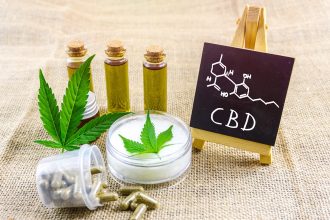Wouldn’t it be nice if you could just pop a candy in your mouth and all your pain and discomforts went away? Well, CBD gummies might be the perfect solution. They come in mouthwatering flavors, great chewy textures, and the goodness of cannabinoids.
Some experts argue about the effectiveness of CBD products when it comes to pain relief, but there’s simply too much evidence supporting the thesis. Both human and animal trials prove that CBD has strong pain-curbing properties.
It can dull down the pain-signaling pathways and allow the user to feel calm and relaxed. But can you use it safely? How much is required? Are there any side effects? Let’s answer all the questions one by one.
What is CBD?
Cannabidiol, or CBD, is a naturally occurring plant compound. It’s present in cannabis sativa plants. CBD is widely popular for its antioxidant, anti-anxiety, anti-inflammatory, and pain-curbing effects.
People consume it in the form of gummies, oils, tinctures, chocolates, and even beverages. It promotes relaxation, reduces stress, and allows the body to heal and recover over time. CBD is a non-intoxicating compound, so there’s no risk of getting high from its daily use.
Plus, as per laws, CBD products cannot have more than 0.3% THC in them, which is the only highly intoxicating compound of cannabis plants. Though 0.3% is very much a safe limit, it enhances the depth of synergistic effects created by cannabinoids in the body.
Other than cannabinoids, CBD products also contain phytonutrients and terpenes, which have their own set of therapeutic properties. CBD products are available for both humans and pets and exhibit similar healing properties in both cases because the working area, the endocannabinoid system, is the same in all mammals.
Due to its safety profile and natural composition, some experts find CBD more effective and safe than opioid-based medications for managing pain.
What is the science behind CBD and pain relief?
The ongoing debate on CBD and pain has advocates on both sides. Some believe that more human trials are necessary, while others find current data sufficient. The current finding does indicate that CBD, when used regularly in moderation, often provides long-lasting relief from chronic pain, neuropathic pain, and general body aches.
For example, this combined analysis of more than 15 studies concluded that CBD reduced pain by 42% by itself and up to 66% when taken along with THC (tetrahydrocannabinol). You’ll also find trials where results were inconclusive. But if you ask people who use CBD regularly, the majority report that they do find it effective for pain and inflammation. So yes, scientific evidence is there, but more research and large-scale trials are necessary.
How does CBD provide pain relief?
CBD provides pain relief in many ways. It improves the working of our body’s internal cannabinoid system, known as ECS. Plus, it also affects certain non-cannabinoid receptors to dull down pain-signaling pathways.
Here are different receptors affected by CBD for reducing overall pain in the body.
- TRPV1 Receptors: CBD binds to TRPV1 receptors, which regulate pain and heat sensitivity. By activating them, CBD reduces inflammation and desensitizes nerves. This process eases pain caused by conditions like arthritis and neuropathy. Hence, cannabinoids block excessive pain signals and provide pain relief in a similar way as opioids but without the risk of addiction.
- GABA Receptors: GABA receptors play a crucial role in keeping us calm. CBD improves its functioning, and as a result, overactive nerve signals become calm and reduce muscle spasms and chronic pain. Some experts think that this is the major reason behind CBD’s ability to reduce fibromyalgia and nerve-related pain conditions.
- 5-H1TA Serotonin Receptors: CBD improves serotonin activity in the brain by stimulating 5-H1TA receptors. This improves the overall mood and reduces our pain perception. This function makes CBD great for dealing with migraine pain, anxiety, arthritis pain, and other physical and emotional discomforts.
- Adenosine Receptors: Adenosine receptors play a crucial role in managing our immune response, inflammation, and pain activity. CBD does not directly affect them but indirectly impacts them by inhibiting equilibrative nucleoside transporter 1 (ENT1). As a result, we feel calm and pain-free within a few minutes of consuming CBD oil.
- Endocannabinoid Receptors: Lastly, CBD’s main pain-curbing properties stem from its ability to improve the functioning of endocannabinoid receptors (CB1, CB2) in mammal bodies. These receptors, by interacting with neurotransmitters (anandamide, 2AG), control our pain, inflammation, mood, and other major body functions.
How much CBD do I need for pain relief?
The exact amount of CBD a person needs for managing pain depends on the severity of pain, their body chemistry, medication history, and tolerance levels. Still, for general body aches and muscle soreness, 10-20mg per day can be a good starting point for beginners.
If you have severe chronic pain because of arthritis, nerve damage, or fibromyalgia, you may need doses as high as 50-60mg per day. But before you go with such high amounts, kindly get in touch with your doctor first.
Higher doses without prior history can upset your stomach, make you dizzy, cause dehydration, and make you lose your appetite. Your body needs time to adjust to the compound, so you should not rush it.
Plus, you need to consume CBD regularly for a long time to experience long-lasting effects. Don’t get discouraged and increase the dosage drastically if you don’t find the results good in the initial days. Also, try to consume it with fatty foods to increase the absorption of cannabinoids in the body and avoid the risk of nausea.
The Key Note
To sum it up, yes, CBD can help with pain, but you’ll need to consume it regularly for at least a few weeks to experience significant relief. There’s enough scientific and anecdotal data to confirm that CBD brings down pain and inflammation in both humans and animals (cats and dogs).
You can buy CBD oil to improve mobility, sleep, and anxiety for both yourself and your furry friend. Just make sure to start with a low dose of 10-15mg and gradually increase it till you hit the perfect dosage.
You can try both topical and edible products like sprays or gummies, depending on what kind of pain you have. Don’t forget to read the lab reports first, though, and buy them only from reputable sources like Colorado Botanicals.














